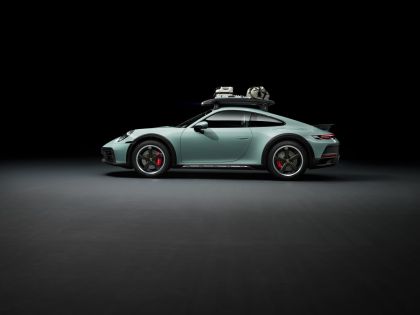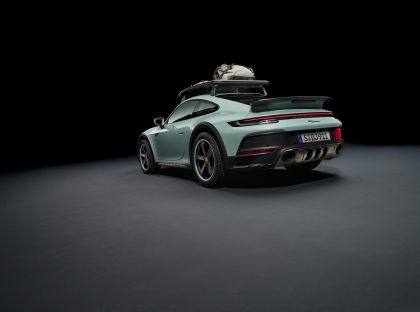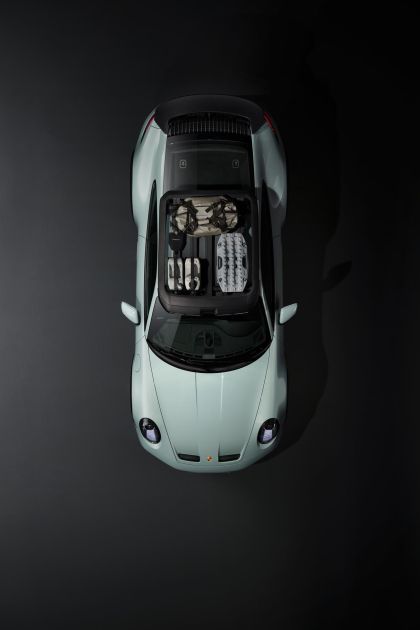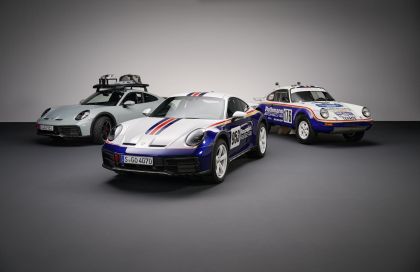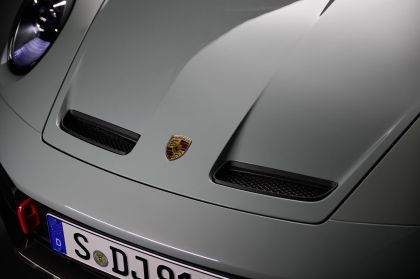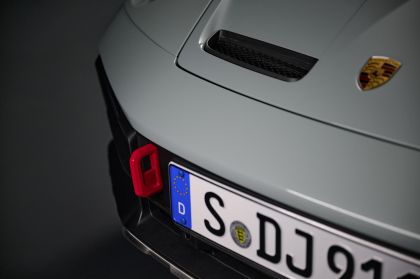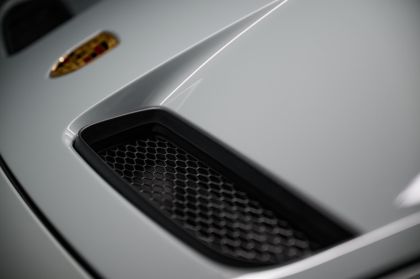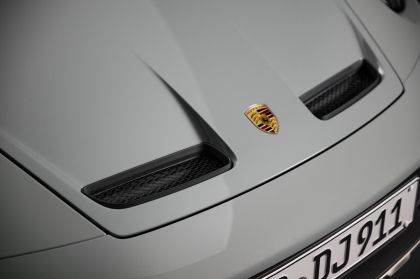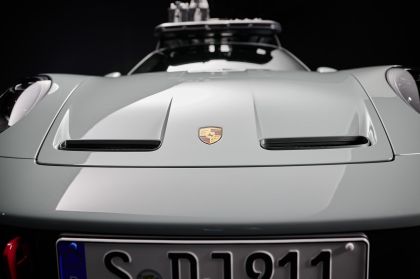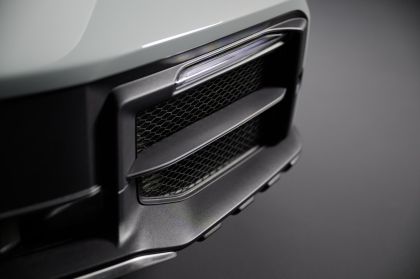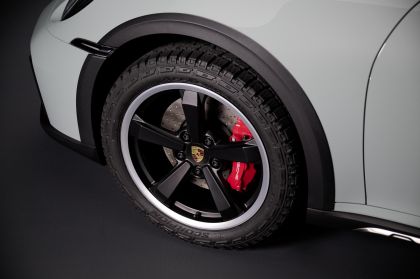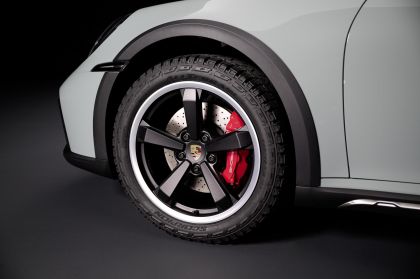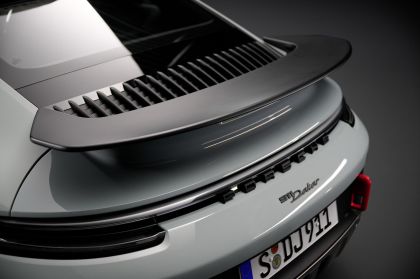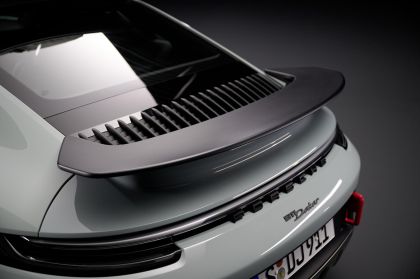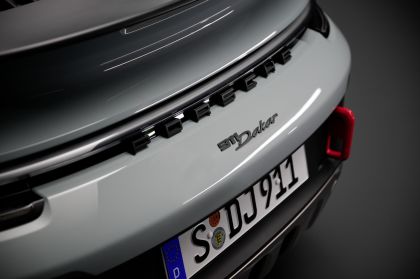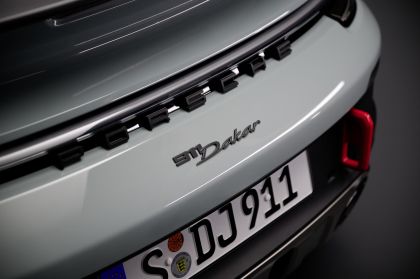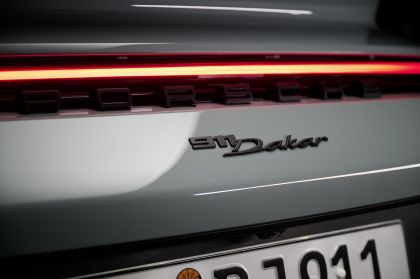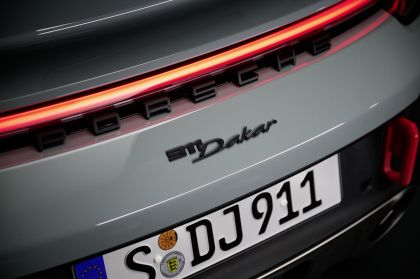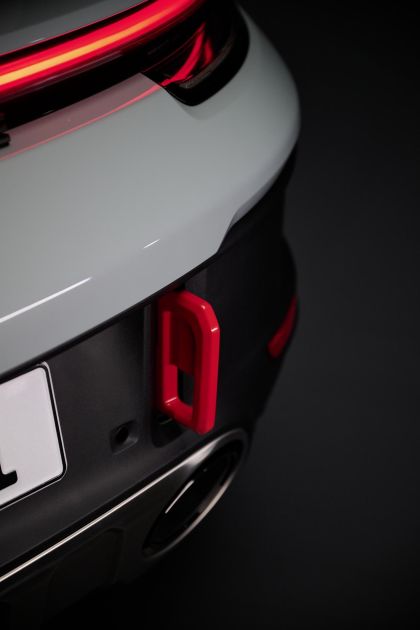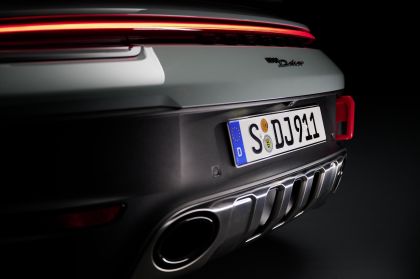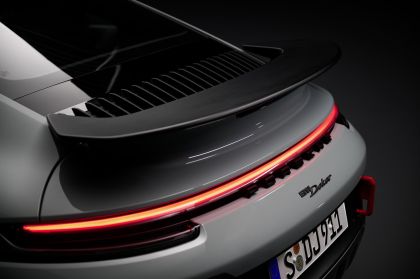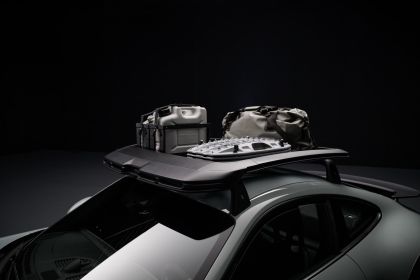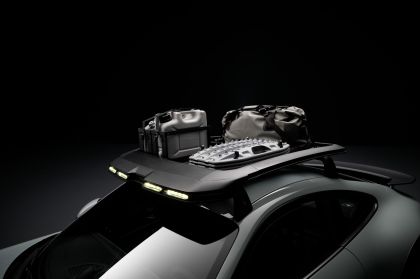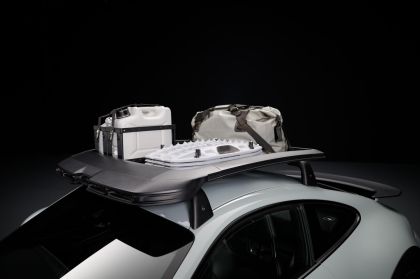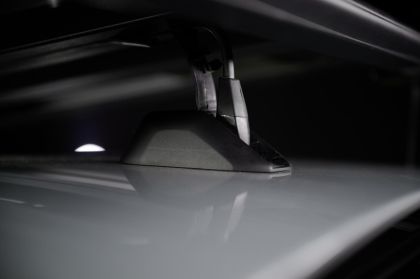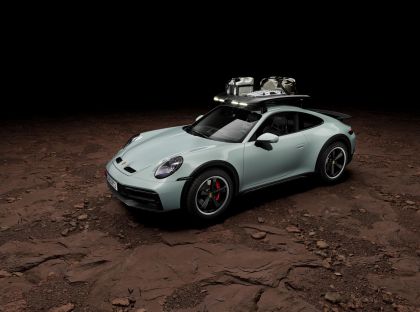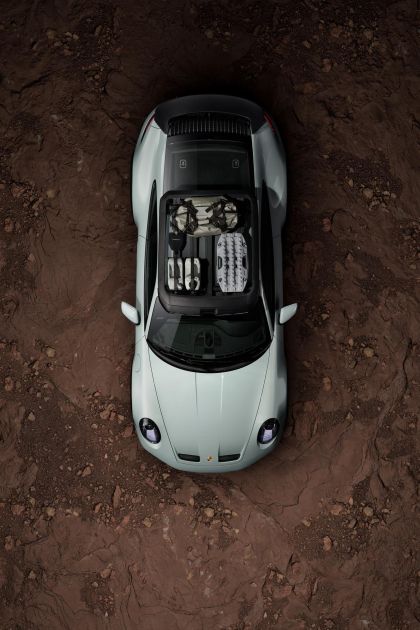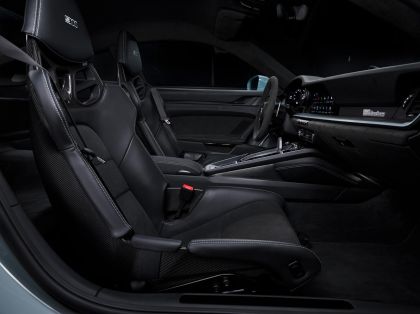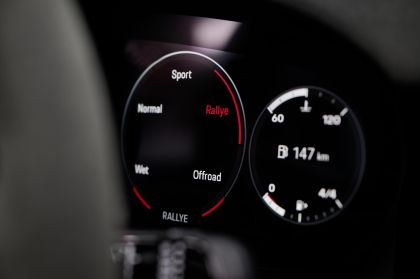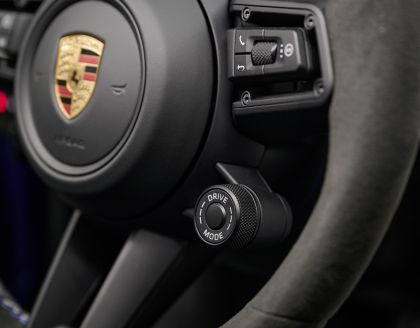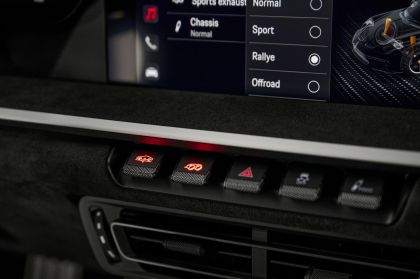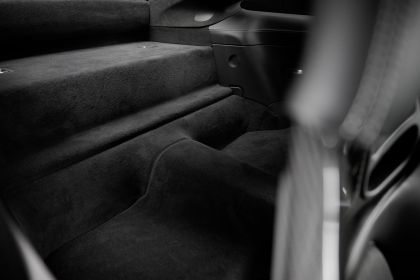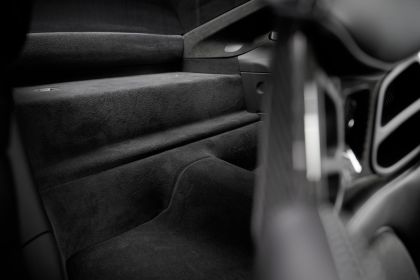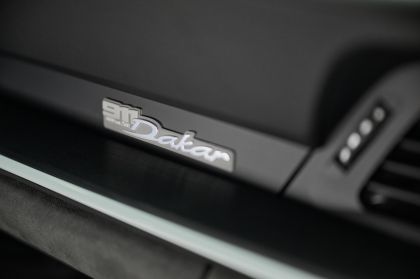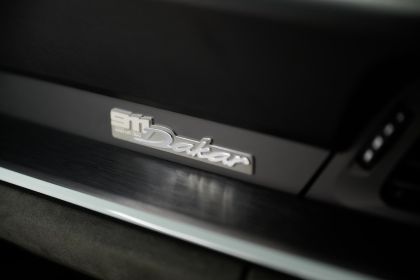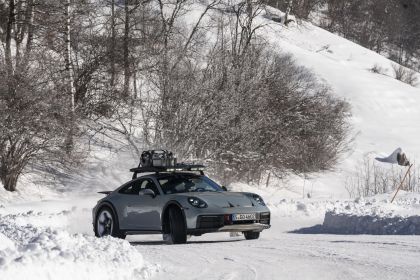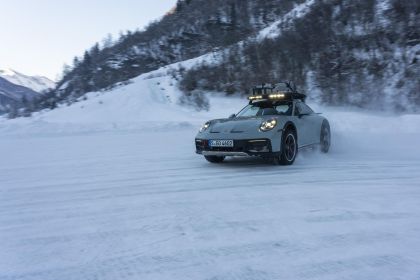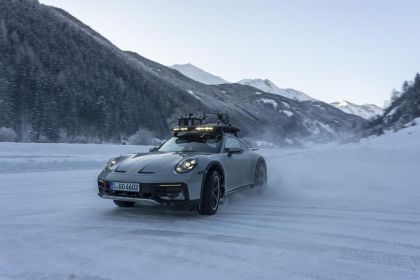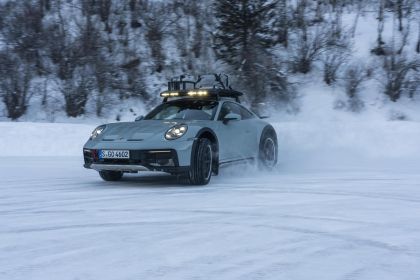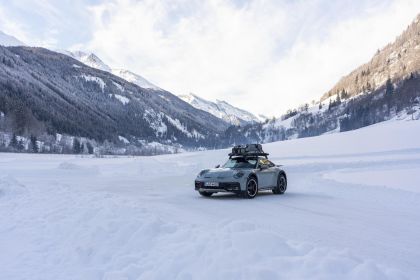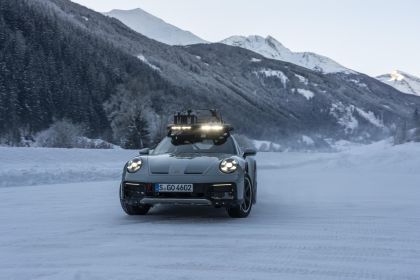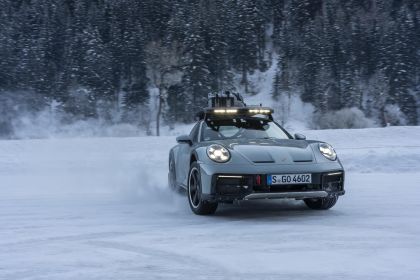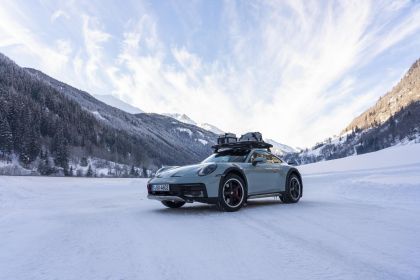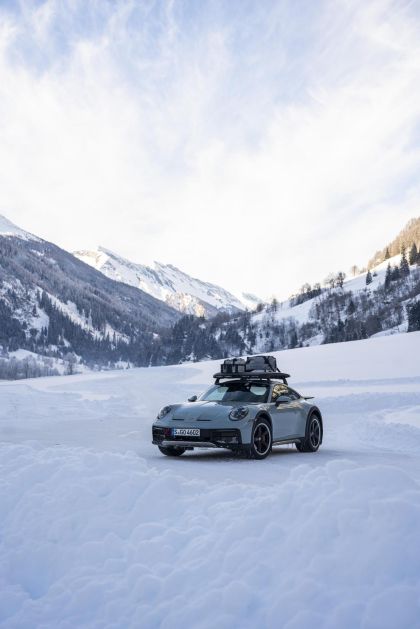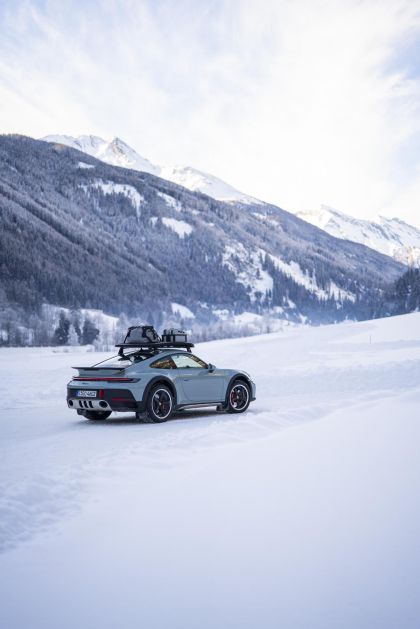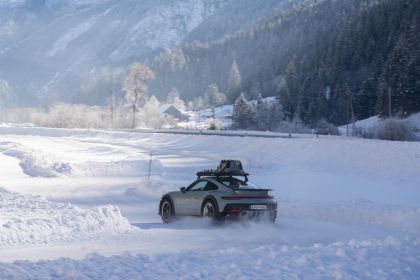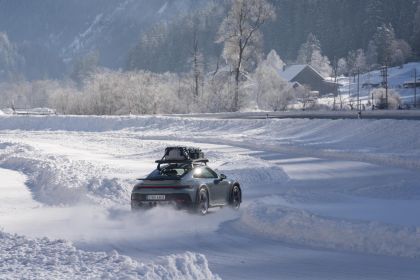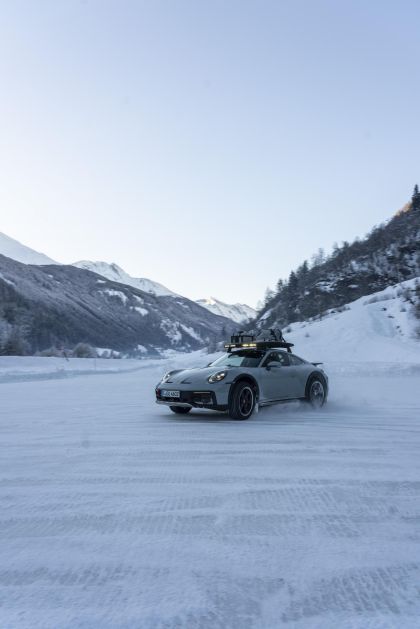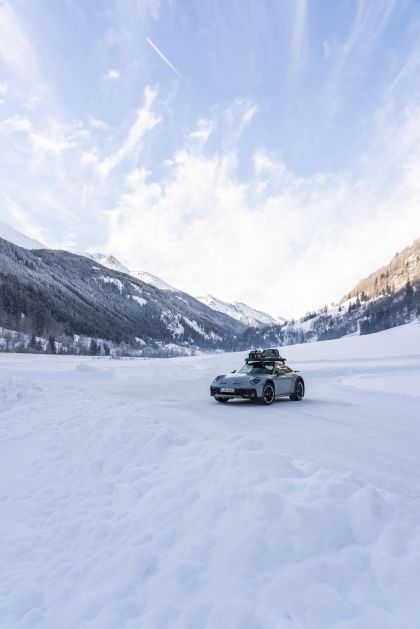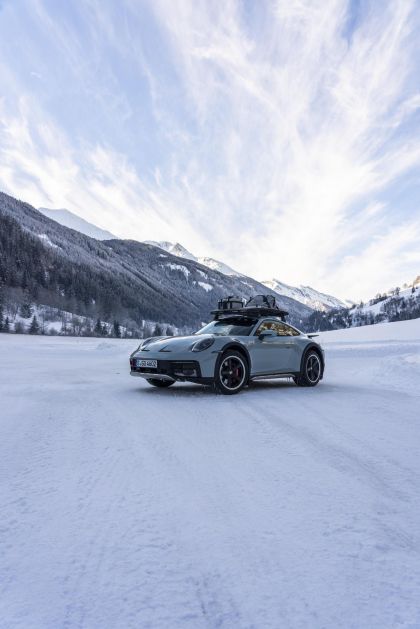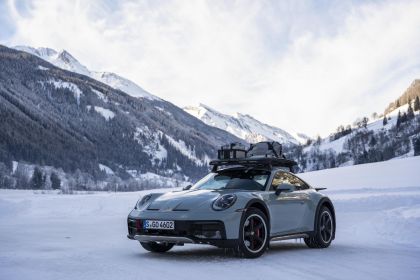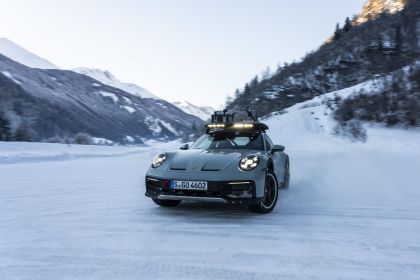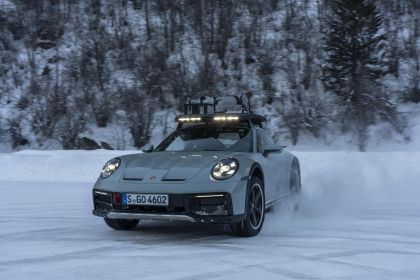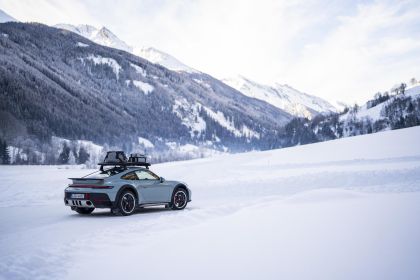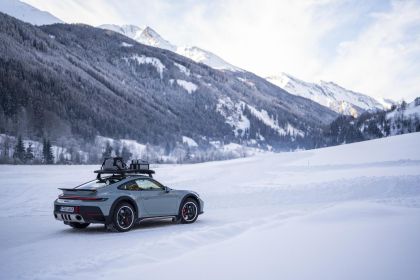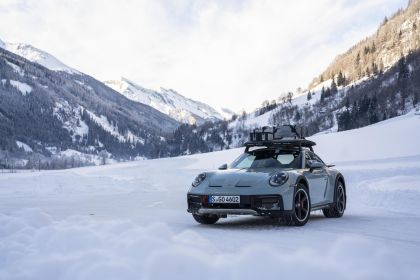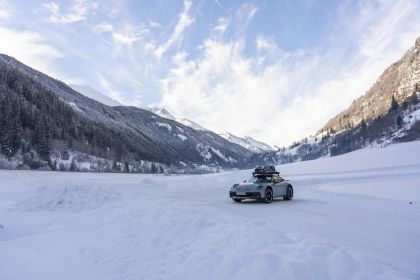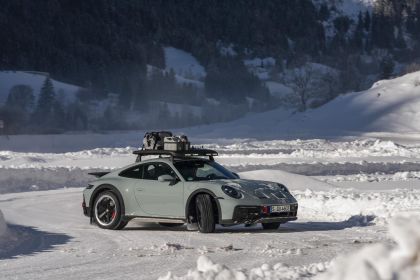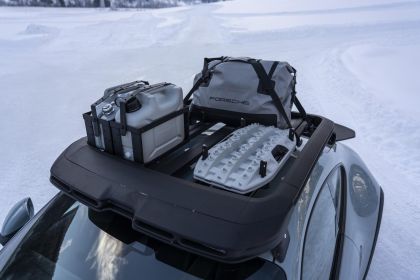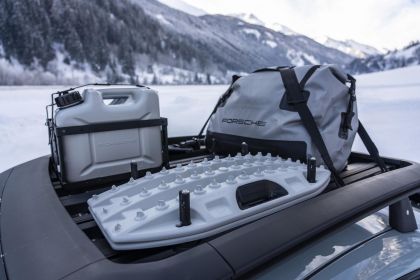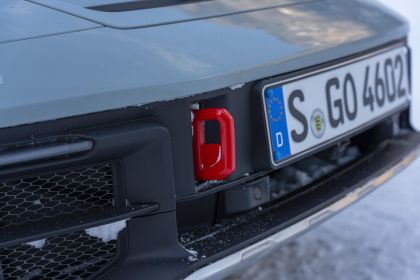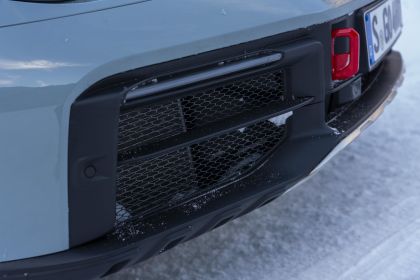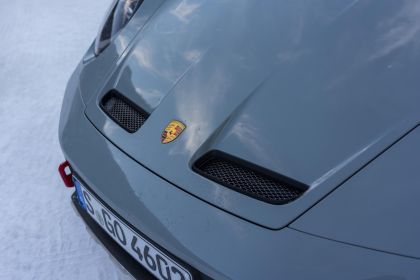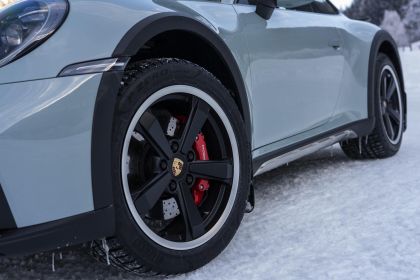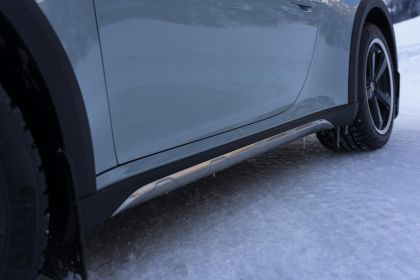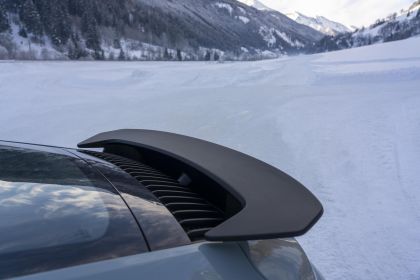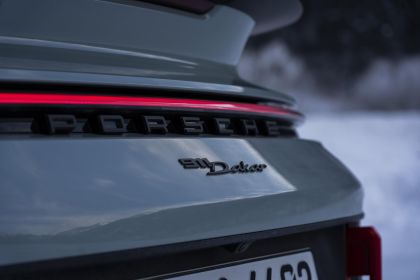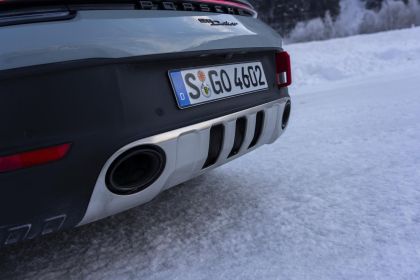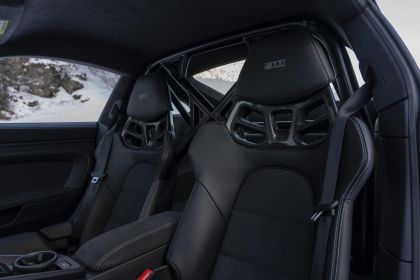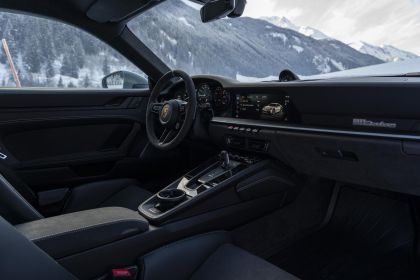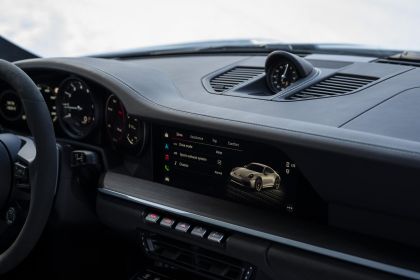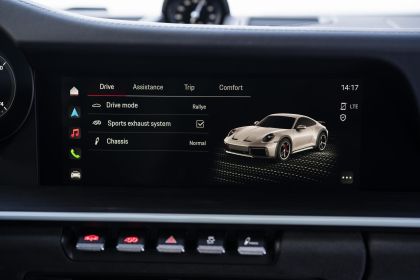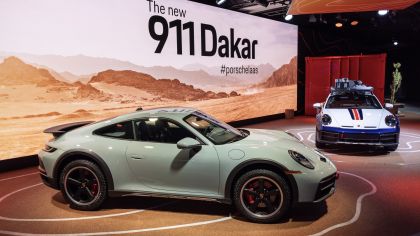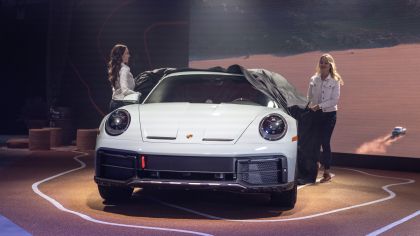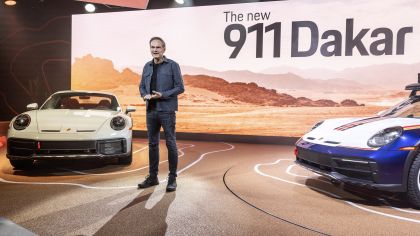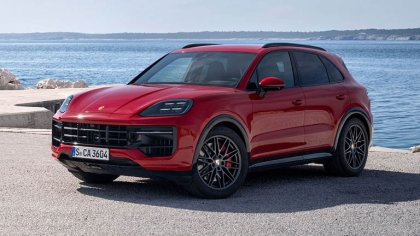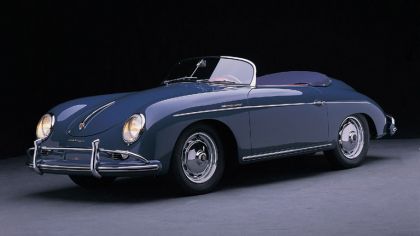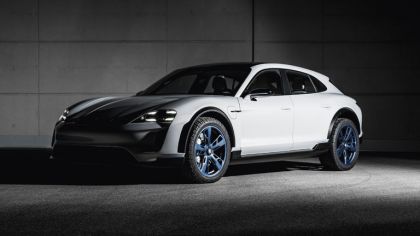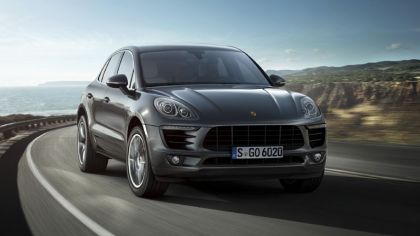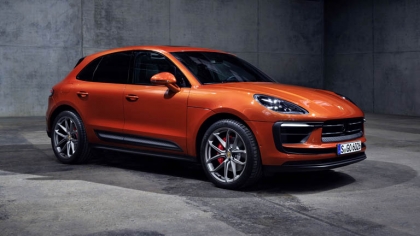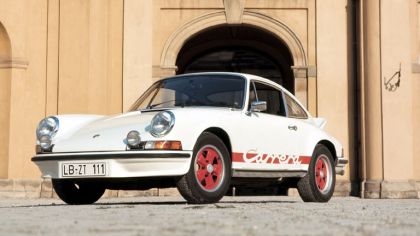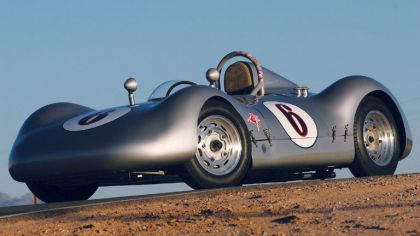At the 2022 Los Angeles Auto Show, Porsche presented the new Porsche 911 Dakar - a sports car that's equally at home off-road as it is on it. The exclusive model, limited to 2,500 examples, shows that there are hardly any limits to the concept of the Porsche 911. The 911 Dakar pays homage the first overall victory by Porsche in the Paris-Dakar Rally of 1984, an event that also marked the birth of all-wheel drive in the Porsche 911.
Significantly increased ground clearance
One thing that immediately stands out is the ground clearance of the 911 Dakar: It is 50 millimetres higher than that of a 911 Carrera equipped with sports suspension. In addition, the standard lift system can raise the ride height by a further 30 mm. Its ground clearance and ramp angle rival those of conventional SUVs. The lift system is not designed merely for driving over obstacles at low speeds, but rather it is an integral part of the re-tuned suspension. The 'high level' setting is available for off-road adventures at speeds of up to 170 km/h. Above that speed, the car automatically lowers back down to its normal level.
Body with off-road characteristics
Additional characteristic features of the 911 Dakar include the newly developed, fixed lightweight rear spoiler made of CFRP, and the CFRP front luggage compartment lid with striking-looking air vents taken from the 911 GT3. There are also standard-fit off-road details such as the red aluminium towing eyes at the front and back, the widened wheel wells and sills, and the stainless steel protective elements on the front, rear and side sills. The side air intakes on the redesigned front end are also protected against stone chips by stainless steel grilles. Carbon-fibre reinforced plastic, CFRP full bucket seats, omitting the rear seats, lightweight glass and a lightweight battery reduce its weight further, enabling the Porsche 911 Dakar to weigh in at just 1,605 kg - a mere 10 kg heavier than the 911 Carrera 4 GTS with PDK.
All-terrain tyres standard for the first time
Complementing the car's sporty off-road attributes are specially developed Pirelli Scorpion All Terrain Plus tyres (the dimensions of which are 245/45 ZR 19 at the front and 295/40 ZR 20 at the rear). The chunky tread pattern is 9 mm deep, and the reinforced sidewalls and the tread consist of two carcass plies. All this makes the tyres of the Porsche 911 Dakar ideal even for challenging terrain, and they exhibit a high cut resistance. Yet at the same time, the tyre offers sports-car performance on asphalt as well. Pirelli P Zero summer and winter tyres, specially developed for the 911 Dakar, are available as an option.
Commanding power with compelling sound
The 3.0-litre biturbo six-cylinder engine with 353 kW (480 PS) and a maximum torque of 570 Newton metres delivers superior performance with a compelling boxer sound. It propels the sports car from 0 to 100 km/h in 3.4 seconds and reaches a top speed of 240 km/h (limited by the all-terrain tyres). Power transmission in the all-wheel drive sports car is provided by an eight-speed PDK.
New driving modes and Rallye Launch Control
The standard equipment also includes rear-axle steering, the exceptionally performance-oriented engine mounts from the 911 GT3 and the PDCC anti-roll stabilisation. Maximum off-road performance is also ensured by two new driving modes (in addition to Normal, Wet and Sport), which can be selected using the rotary dial on the steering wheel. Rallye mode is ideal for loose surfaces and features rear-biased all-wheel drive. Offroad mode automatically operates at a raised ride height and with a significantly stiffer differential locking effect. The focus is directed at maximum traction in dunes or on hard, uneven ground. Both of the new driving modes also feature the new Rallye Launch Control, which allows wheel slippage of around 20 per cent.
Rallye Design Package with styling that echoes that of the 1984 Paris-Dakar-winning rally car
At the heart of the optional Rallye Design Package is a two-tone paint finish in White/Gentian Blue Metallic. Porsche is offering two-tone paintwork as standard for the first time. The red and gold stripes are applied by hand in Zuffenhausen in the Porsche Exclusive Manufaktur. On the side of the car, the customer can choose an individual race number between 0 and 999. In addition to the red and gold rally stripes, the 911 Dakar with Rallye Design Package - the appearance of which is based on the winning vehicle of the 1984 Paris-Dakar Rally - also bears the 'Roughroads' lettering on the doors. The term is a registered trademark and reflects the concept of the Porsche 911 Dakar and its suitability for driving off road. The white-painted rims and the red taillight strip, in contrast to the standard 911, round off the distinctive appearance. Further highlights can be found in the interior: the interior trims and the decorative inlays on the dashboard and the interior door handle are in Ceramica White. There is also extended Race-Tex and leather surrounds as well as seat belts and accents in Shark Blue.
Rising to the occasion with the standard lift system
One of the most striking new features of the Porsche 911 Dakar is the significantly increased ground clearance. At 161 mm, it rides some 50 mm higher than that of a 911 Carrera with sports suspension. When the standard lift system is activated, the ride height is raised by an additional 30 mm on the front and rear axles. This gives the 911 Dakar a maximum ground clearance of 191 mm.
The body can be raised to the high level manually using a button. In Offroad mode, the ride height increases automatically. The actuating elements in the spring struts are operated hydraulically. The lift system in the 911 Dakar is based on the same principle as the already-familiar front axle lift system. To equip the system for the more demanding requirements and for use as a ride height at speeds of up to 170 km/h for the front and rear axles, substantial modifications had to be undertaken. Among them was a pressure accumulator, which adjusts the system pressure as needed. The expansion tank was adapted to the increased filling quantity. The pressure level of roughly 110 bar in the familiar front axle lift was increased to 135 bar. Driving at the raised level is possible at speeds of up to 170 km/h. Above the 170 km/h barrier, the system automatically lowers the ride height to the normal level.
Longer spring travel and lower spring rates
The running-gear setup in the 911 Dakar follows the same basic philosophy as all Porsche 911 models: a huge performance range spanning driving comfort and sportiness matched with unlimited day-to-day usability. To broaden the use spectrum of the 911 Dakar, specific modifications to the setup were undertaken to meet both the on-road and off-road requirements. The spring struts used in the Porsche 911 Dakar are longer and offer greater compression and extension travel both at the front and rear. The spring rates are considerably lower. In addition, all standard chassis systems (PASM, PDCC dynamic anti-roll stabilisation and rear-axle steering) as well as the all-wheel-drive and differential control (PTM and PTV Plus) received new setups. Along with the familiar driving modes Normal, Wet and Sport, drivers now also have access to the two new modes exclusive to the Dakar: Rallye and Offroad.
In Rallye mode, the engine, PDK and accelerator offer a dynamic setup akin to the Sport+ mode in other 911 models. And the traction control also allows more wheel slippage on loose ground. Suitable surfaces for Rallye mode, which is tuned for exceptional driving pleasure, include gravel, wet grass and muddy, rutted forest paths. In Offroad mode, the engine, PDK and accelerator respond just like they do in Rallye mode, but the car is automatically adjusted to the higher ride height level and therefore has an additional 30 mm of ground clearance. At the same time, the all-wheel drive provides sufficient torque to the front axle to balance the speeds of the front and rear wheels. And the rear differential lock can be closed, ensuring that no rotational speed differences occur between the left and right rear wheels. Offroad mode therefore provides optimal traction on demanding terrain as well as high torque control anticipation. The Offroad setting is particularly well suited to dune surfing and driving over uneven surfaces on hard ground.
Spectacular acceleration with Rallye Launch Control
The new Rallye Launch Control is available in both Rallye and Offroad mode. Like the classic Launch Control, which remains part of Sport mode, it offers the driver maximum acceleration from a standstill. Since Rallye Launch Control is used on loose ground such as sand and gravel, it can handle slippage of up to 20 per cent. The wheels are allowed to spin within certain limits, which gives the driver a particularly intense and exhilarating acceleration experience.
The entire steering setup has also been reworked and adapted to a broader range of requirements. It impresses with its responsiveness on all surfaces and always provides clear feedback as to how much grip there is on the front axle. Part of the credit for the excellent traction in the new Porsche 911 Dakar on rough terrain goes to the all-terrain tyres from Pirelli, the first such tyres to be developed for a Porsche series-production model. Fitted as standard, the tyres are 245/45 R by 19 inches at the front and 295/40 R by 20 inches at the rear. With their larger cross-section, and therefore a higher sidewall, they contribute 10 mm to the increased ground clearance of the 911 Dakar. The bigger cross-section also necessitates the use of 19-inch wheels in the front and 20-inch wheels at the rear. This makes the rims on the 911 Dakar one inch smaller than those on the 911 Carrera GTS.
Off-road sports car tyres
Specially developed for the Porsche 911 Dakar, the all-terrain tyres boast pronounced off-road characteristics. Yet they offer sporty qualities and surprising levels of lateral grip on the road as well. The all-terrain tyre features a highly robust design. Its specially designed profile with a depth of more than 9 mm and the reinforced sidewalls and treads with two carcass plies give it a high cut resistance. The double carcass also increases the stiffness of the sidewalls by roughly 40 per cent, which is a boon during spirited driving over rougher terrain. With this all-terrain tyre, the 911 Dakar can not only handle demanding off-road conditions with ease, but also reach a top speed of 240 km/h. Pirelli P Zero summer and winter tyres, also newly developed for the 911 Dakar, are available as an option.
SUV-like breakover angle
The basic architecture of the 911 offers a good basis for off-road use that has been further optimised by making modifications to the body. The front overhang is 16 mm shorter, which together with the higher ground clearance increases the car's approach angle, which has risen from eight to 16.1 degrees. The breakover angle is 19 degrees, making it comparable to the Cayenne or Macan.
Every component that distinguishes the 911 Dakar from other 911 models assumes an important role in the overall concept of the off-road sports car. The newly developed, fixed CFRP rear spoiler replaces the adjustable spoiler of the Carrera models in favour of greater robustness when exposed to large amounts of dirt and mud. It optimises the air flow to the intercoolers and increases downforce on the rear axle. This improves the lift balance - not least since the characteristic 911 front spoiler lip has been removed to improve the front slope angle. The wheel arch extensions made of impact-resistant black plastic take the increased track widths into account: the track has been widened by 28 mm at the front and 15 mm at the rear. The widened door sills and the lower edges of the newly designed front and rear aprons feature stone chip protection made from stainless steel sheeting. The protective grilles for the front side air intakes are also made of stainless steel. Red towing eyes made of forged aluminium are fixed elements at the front and rear.
Optional roof rack or roof tent as well as Porsche Design chronograph
The roof of the Porsche 911 Dakar features a visible 12-volt power outlet for the LED spotlights of the optional roof rack. With a capacity of 42 kg, the rack can accommodate typical off-road equipment such as fuel and water canisters, folding shovels and traction boards without any problems. A roof tent is also available for the 911 Dakar. Inside, the 911 Dakar underscores its sporting ambitions with standard full bucket seats and the omission of the rear seats. A defining feature of the Dakar's interior is the standard Race-Tex surfaces with decorative stitching in Shade Green, which is also exclusively available as a metallic exterior finish for the 911 Dakar. The Rallye Sport Package with roll-over bar, six-point seat belts and fire extinguisher, is available as an option in most markets. Those who buy the 911 Dakar can exclusively order the Porsche Design Chronograph 1 - 911 Dakar or the Chronograph 1 - 911 Dakar Rallye Design Edition to match the vehicle. For the first time, the housing of these is made of particularly scratch-resistant and light titanium carbide.
Radiator with stone chip protection
In keeping with its specialised uses, the 911 Dakar has a modified cooling system that makes particular allowance for cooling requirements in off-road scenarios. The side cooling modules are equipped with stronger fans. The grilles were specially developed for the 911 Dakar and offer an ideal compromise between air throughput and stone chip protection.
With the increased ride height and extensive standard equipment with lift function, along with the high-quality PDCC chassis systems and rear-axle steering, the vehicle weight is higher than that of the Carrera 4 models. Engineers were able to largely counteract this added bulk by using lightweight construction measures. The 911 Dakar has no rear seats, for example, and the standard full bucket seats made of CFRP are also exceptionally light. Additional weight is saved by the use of a CFRP bonnet, CFRP rear spoiler, a lightweight battery and lightweight glass in the front, rear and front side windows. The movable cooling air flaps have also been removed for the off-road setup in the Dakar model. All in all, the empty Porsche 911 Dakar weighs in at 1,605 kg - just 10 kg more than the 911 Carrera 4 GTS with PDK, despite substantial extra equipment.
LED spotlights on the roof rack
A notable feature on the roof of the 911 Dakar is the new addition of an integrated power socket - a 12-volt connection that supplies the roof-mounted spotlights with power. This special roof rack is optional, though the roof power socket and the integrated securing system are standard features in the 911 Dakar. Use of the spotlights on the roof rack, which can be switched on using a button in the roof console, is only permitted when not driving on public roads.
Exclusive look
The new Shade Green metallic paint makes its debut in the 911 Dakar. The car can also be ordered in three familiar colours: GT Silver Metallic, Black and White. The special colours of Ice Grey Metallic and Shark Blue are also available. The 19- and 20-inch Dakar wheels come standard in Black (satin finish) and are optionally available in Vesuvius Grey (satin finish) or White.
Inside, the standard full bucket seats and the absence of rear seats instantly catch the eye. The Shade Green colour is featured as a contrasting tone inside as well - in the contrasting seams for instance, as the 12-o'clock marker on the GT sports steering wheel in Race-Tex, on the dashboard trim and as the visible background of the Race-Tex centre panels of the seats. The dashboard features a badge with the individual build number of the vehicle. Porsche is building 2,500 examples of the Porsche 911 Dakar. The selector lever for the eight-speed PDK is made of aluminium, while the door sill guards feature black brushed aluminium and bear the 911 Dakar logo. Optionally, LED projectors in the doors, which project the 911 Dakar logo on the ground when the doors are opened, can be specified.
Rallye Design Package pays homage to the 1984 Paris-Dakar triumph
The Rallye Design Package is available as an option. It establishes a direct visual link to the Porsche team that won the Paris-Dakar Rally in 1984. The cars featured two-tone paintwork in blue and white, and had red and gold decorative stripes as decals. The new Rallye Design Package is painted with a two-tone White/Gentian Blue Metallic finish and features the "Roughroads" logo. The word evokes memories of days gone by, while also embodying the idea of the 911 Dakar: this is a car for rough roads. Porsche has registered the designation as a trademark.
The Porsche 911 Dakar with Rally Design Package is the first series-produced combination of dual-colour paint and adhesive film. New painting technology was developed and new work procedures established for the purpose. The manual masking and painting processes were also integrated into the series production process for vehicle painting. The large-scale film wrap is applied by hand by Porsche Exclusive Manufaktur.
In the Rallye Design Package, the rear spoiler and Dakar wheels are White. In the interior, the contrasting colour is Shark Blue instead of Shade Green. The safety belts also feature Shark Blue, as does the embroidered 911 logo in the headrests. Race-Tex material is also used generously in the Rallye Design Package, being additionally featured in the roof lining, on the dashboard, the sun visors and the floor mats. The interior trims and the decorative inlays on the dashboard and the interior door handles are in Ceramica White. Small LED projectors feature in the doors. They project the 'Roughroads' logo and the profile of the all-terrain tyres onto the ground when the doors are opened. The Rallye Design Package is available for €26,061 incl. VAT. The "Rallye Design extension package" can be ordered as an option for the vehicle interior. It includes additional details in Race-Tex including decorative stitching in Shark Blue - from the inner door sill trim to the fuse box cover and the vehicle document folder, to the central air vent housing with slats in leather. Another eye-catching feature is the interior mirror console clad in black Race-Tex with decorative stitching in the same shade of colour. The expansion package can be ordered at a price of €2,957.15 including VAT.
Three decal sets in the 1970s rally style
The rally history of the Porsche 911 well away from paved roads began before the first victory in the Paris-Dakar Rally in 1984. Early forays in the East African Safari Rally in the 1970s remain a strong memory. While the styling of the optional Rallye Design Package for the 911 Dakar draws heavily on the winning car of 1984, Porsche offers three exclusive wraps for the 911 Dakar that reprise the look of the 1971, 1974, and 1978 entrants in the East African Safari Rally.
This event took participants more than 5,000 km through savanna, desert scrubland and the highlands of Kenya and is regarded as one of the toughest rallies of all. Porsche undertook the challenge for the first time with a works team in 1971. Outwardly, the modified 911 S models were only identifiable by the simple black decals on the bonnet, the front wings and the doors. The Rallye 1971 decal set for the 911 Dakar revisits this design and adds the competition number 19, which belonged to the most successful 911 in this rally - a car that came fifth in 1971, driven by Polish drivers Sobiesaw Zasada and Marian Bie. The decal set is available for €4,165.
The East African Safari Rally featured incredibly long stages - in 1974, the race was divided into three sections of 1,450 to 2,019 kilometres, which the teams had to complete in just five days. Of the 99 cars that entered, only 16 made it to the finish line. Swedish rally champion Björn Waldegård, who had already won the Rallye Monte Carlo twice in a Porsche, held the lead for a long while alongside co-driver Hans Thorszelius in the 911 Carrera 2.7 RS and started the third section with a 36-minute gap on second place. But a damaged wishbone cost him 72 minutes, and in the end Waldegård held on to finish second. Characteristic of the decals of the main sponsor were the blue stripes that traced the shoulder lines of the otherwise white car. The current wrap takes up this theme, albeit with narrower stripes and augmented by the Porsche logo on the lower edges of the doors. The Rallye 1974 decal set is available for €4,165.
Björn Waldegård wasn't finished. With one of three 911 SC Group 4 cars custom built for the purpose, the Swede gave it another go in Kenya and quickly showed the competition that he was set on victory. In the end, however, the East African Safari Rally would again prove treacherous: wishbone, shock absorber, drive shaft - Waldegård's Porsche sustained too much damage, in some cases far from helping hands. The speedy Swede had to be content with fourth place, while the South African duo of Vic Preston Jr. and John Lyall took second. The sponsor's decals consisted of wave-shaped surfaces in orange and light and dark grey, familiar around the world thanks to the activities of the Martini Racing Team founded in 1958. Once again, Porsche designers have respectfully reinterpreted the historic decals here. The competition number 14 on the doors was that of second-placed Vic Preston Jr. The Rallye 1978 decal set is available for €5,950.
Commanding power source - and a compelling sound
The new Porsche 911 Dakar has an exceptionally dynamic and impressive powertrain: a 3.0-litre six-cylinder boxer engine with twin turbochargers and 353 kW (480 PS). The engine delivers its maximum torque of 570 Newton metres at just 2,300 rpm and holds this figure through to 5,000 rpm. The engineers have created a compelling, rich sound experience for the 911 Dakar, which has been achieved using the standard sports exhaust system.
The six-cylinder boxer comes standard with an eight-speed PDK to distribute the power to all four wheels. It propels the new off-road sports car from 0 to 100 km/h in 3.4 seconds and reaches a top speed of 240 km/h (limited by the all-terrain tyres).
The air intakes and cooling have been modified for off-road use. Due to the higher exposure to dust, particularly while drifting, the enhanced air filter from the 911 Turbo has been fitted. The air filter box is equipped with a support grille and mounted with the more powerful fan motor from the 911 Turbo. They are equipped with 650-watt fans, which ensure adequate cooling even during slower drives over off-road terrain in hot temperatures. The more powerful alternator from the 911 Turbo is also installed on the engine.
The engine mounts, which help increase the stiffness of the engine's connection with the chassis by 100 per cent, come from the 911 GT3. This optimises handling during dynamic manoeuvres as well as reducing bottoming-out and the development of engine vibrations on uneven terrain.
Individually expandable
In addition to the extensive standard equipment for performance, driving dynamics and off-road capabilities, the Porsche 911 Dakar also features the highest-quality solutions for comfort and safety. The standard equipment package includes dark-tinted LED main headlights with matrix beam, incl. PDLS Plus, HomeLink® (garage-door opener), Sport Chrono Package, GT sports steering wheel, Warn and Brake Assist, comfort access and ParkAssist including reversing camera and SurroundView. A generous array of infotainment equipment provides entertainment and connectivity, while the audio reproduction in the car is enhanced by a standard Bose® Surround Sound System.
The optional Rallye Sport Package, which can be ordered in most markets, offers protection that has been optimised even further on off-road and rally drives. The package consists of a black-painted and powder-coated steel roll-over bar fitted behind the front seats and secured to the body. The Rallye Sport Package also includes two six-point seat belts and a fire extinguisher.
Roof rack and roof tent
In addition to all this, Porsche Tequipment offers special equipment packages for the 911 Dakar, including a roof rack that can be used to store matching accessories. Options include fuel and water canisters, traction boards and a folding shovel. Porsche Lifestyle offers matching, exceptionally robust luggage. The roof rack weighs 28 kg and can handle a payload of 42 kg. Its LED lighting is supplied with power by using the standard roof power socket on the 911 Dakar via a magnetic coupling. The LED lights can be switched on and off with a button in the interior roof console. Use of this additional lighting is not permitted on the public highway.
Instead of the roof rack, a two-person fold-out tent can be fitted on the roof transport system. In addition to the tent, the hard case with its Porsche-specific design also contains a ladder, a mattress, anti-theft protection and storm protection. The tent can be set up within minutes in just a few steps. It weighs 58 kg and is designed for a maximum load of 140 kg.
Motorsport history in a watch
Hand crafted in Porsche's own watch factory in Solothurn, Switzerland, the Chronograph 1 - 911 Dakar and the Chronograph 1 - 911 Dakar Rally Design Edition reprise the striking highlights of their automotive namesakes and make a lasting impression with a world premiere: a highly scratch-resistant titanium carbide case developed by Porsche Design. The chronographs are reserved exclusively for owners of the Porsche 911 Dakar and are therefore limited to just 2,500 units. The limited-edition number corresponds to the build number of the car and is engraved on the back of the casing.
After five years of intensive development work, Porsche Design has succeeded in forming a chronograph case out of titanium carbide, an exceptionally robust and highly scratch-resistant material. This is very much in the spirit of Ferdinand Alexander Porsche, who once said: "It gives me pleasure to make things better." Porsche Design did not merely coat the case with titanium carbide, but in fact made it entirely from this revolutionary material. For this purpose, granules are first pressed under several tons of pressure before being fired at over 2,000 degrees Celsius. The resulting blank is then milled into the final shape and fine polished. Titanium carbide prevents the visible ageing process and is even lighter than titanium. The ceramic material is notable for its striking black powder look and elegant crystal structure. The abbreviation TiC for titanium carbide features on the distinctive red of the instrument dial.
Fine distinctions in the design
As with the 911 Dakar models with and without the Rallye Design Package, there are also fine differences in the designs of the two chronographs. The instrument dial of the 911 Dakar Rallye Design chronograph, for example, has a 'Roughroads' graphic that evokes the car's design. Moreover, the backing of the vehicle-leather band features Race-Tex in Shark Blue instead of the Shade Green in the 911 Dakar chronograph.
Both designs of the 911 Dakar chronograph reinvigorate the legend of the most famous rally in history and celebrate unmistakable design details of the new Porsche 911 Dakar. In this way, owners of this extraordinary car can also wear a piece of motorsport history on their wrist.
How the 911 became all-wheel drive
With more than 30,000 individual wins, Porsche is one of the most successful brands in motorsport history. And rally cars have repeatedly added to that number. Way back in January 1965, just four months after it went on sale, the Porsche 911 entered the Rallye Monte Carlo and took fifth place. Three years later, Vic Elford recorded the first 911 win in Monaco, with the Englishman driving a 911 SC 2.0. In 1969 and 1970, the Swede Björn Waldegård repeated the feat. And in each of those years, another rally-spec 911 took second place in the Rallye Monte Carlo.
The World Rally Championship as we know it today was first held in 1973, while there has been a title for the most successful driver since 1979. Porsche has never competed in the overall championship, but has taken part in individual races. In the 1970s, Porsche also entered the 911 in East African Safari Rallye, a race through Kenya across roughly 5,000 km that was part of the World Rally Championship (though Porsche was not challenging for this). A Porsche 911 took fifth in 1971, and a 911 came in second place in both in 1974 and 1978.
Group B paves the way
In 1981, Walter Röhrl, the previous year's champion, joined Porsche for a single season and drove the 924 Carrera GTS in the German Rally Championship. In the World Rally Championship, he raced only the Rally San Remo in the 911 SC.
Porsche, meanwhile, was gathering its forces for a new concept: In 1982, the FIA - the world motorsport federation -introduced Group B regulations for extremely powerful GT cars that could also be used in the World Rally Championship. In 1983, the first concept study of the future super sports car - the 959 - was exhibited at the IAA in Frankfurt. It bore the telling model name 'Gruppe B'. The 959 would be the first series-production Porsche with all-wheel drive, but the development of this new drive concept had begun in the early 1980s with the 911. At the IAA in 1981, Porsche had unveiled a concept car that united the highlights of the Cabriolet, Turbo and all-wheel drive. Its name: The Porsche 911 Turbo 3.3 4x4 Cabriolet.
This prototype was later extensively tested by Walter Röhrl, among others. And when Jacky Ickx, the four-time Le Mans-winner in a Porsche, saw the prototype being driven in Weissach, he had an idea: He wanted to enter the Paris-Dakar with a rally 911 and all-wheel drive. This 11,000 km extreme rally, which was held outside the auspices of the World Rally Championship, had been gaining in renown year by year since 1979, and Ickx had already won it in 1983 with a Mercedes 280 GE.
Internal name of the Dakar 911: 953
Ickx's idea meant the chance for a successful pioneering programme for Porsche. Head of Development Helmuth Bott gave his assent, Ickx got the cigarette brand Rothmans to agree to sponsor the Paris-Dakar entry, and three Porsche 911 Carrera 3.2 cars with all-wheel drive and numerous rally upgrades were fitted out for the race. Official type designation: Porsche 911 Carrera 3.2 4x4 Paris-Dakar. Internally, the car was known simply as the 953.
Alongside Ickx and co-driver Claude Brasseur, the Frenchman René Metge, Dakar winner in a Range Rover in 1981, with his co-driver Dominique Lemoyne, plus Porsche project manager Roland Kussmaul and co-driver Erich Lerner, also joined the driver crew ranks. Ickx and Metge were to drive for a result, and victory if possible, while the Kussmaul/Lerner team were deployed as a rolling testbed. There was also a mechanic crew in the truck classification on hand to support the three 911s.
The established competition with their all-terrain vehicles didn't take the Porsche foray seriously at first, but they would soon know better. While the 911 Carrera 4x4 driven by Jacky Ickx had a breakdown on the first day in the desert due to a rock impact and the repairs took hours, René Metge lived up to his reputation as a virtuoso desert driver and cruised the sand and gravel at speeds of 150 km/h and more. The rally 911 was several hundred kilograms lighter than the big all-terrain vehicles, while the boxer engine delivered 165 kW (225 PS) - two winning feathers in the Porsche cap. The big traction advantage of the rear engine was a boon in every rally, and the Paris-Dakar was no exception. And when tackling big dunes with lots of soft sand, the teams could actuate a lever in the centre console to lock the differential between the rear and front axles - creating a jolting driving experience in the 911 Carrera 4x4, but with maximum traction.
First place for the complete Porsche team
In the end, Metge took overall victory. Ickx doggedly moved up from 139th place to take sixth, while Roland Kussmaul came in an impressive 26th - securing first place in the team classification.
After this massive success, Porsche entered the Paris-Dakar again the following year, this time with the first 959. According to the Group B rules, at least 200 series-production cars had to be sold for homologation - a condition Porsche had fulfilled with confirmed orders shortly after the IAA in 1983. Porsche therefore entered a rally with the precursor of a Group B car for the first time. Alas, the 400 PS biturbo engines were not finished in time. So, in 1985, it was not three 911s with 959 components at the start as in the year before, but three 959 cars with 911 engines. Due to the vagaries of the Paris-Dakar, none managed to make it to the finish line, so they tried again the next year - and won. Again it was René Metge/Dominique Lemoyne who secured the victory for Porsche. Ickx/Brasseur took second on this occasion, while Kussmaul and his co-driver took sixth.
After this triumph, Porsche ended its run at the Paris-Dakar. The 959 would ultimately not appear in the World Rally Championship either, as the FIA banned the use of Group B cars in the competition at the end of 1986. The highly refined cars had proved too dangerous and were only allowed to drive in the European Rallycross Championship. Porsche was not interested.
Five years after the first triumph came the 911 Carrera 4
What remained as the legacy of the Paris-Dakar races was the road-legal 959 as the most powerful Porsche production model to date at the time: with 336 kW (450 PS), the 959 easily surpassed both the 911 Turbo and the eight-cylinder 928 in the late 1980s. Another even more important benefit was that although just 292 examples were built, the 959 was the first series-production Porsche with all-wheel drive. The G-series 911, on which the 911 Carrera 4x4 for Paris-Dakar was based, remained on sale until 1988 and did not feature all-wheel drive. However, with the launch of the third 911 generation - the 964 - the time had come: before 1988 was out, and even though it was designated as a 1989 model year car, a Porsche 911 Carrera 4 was launched.

